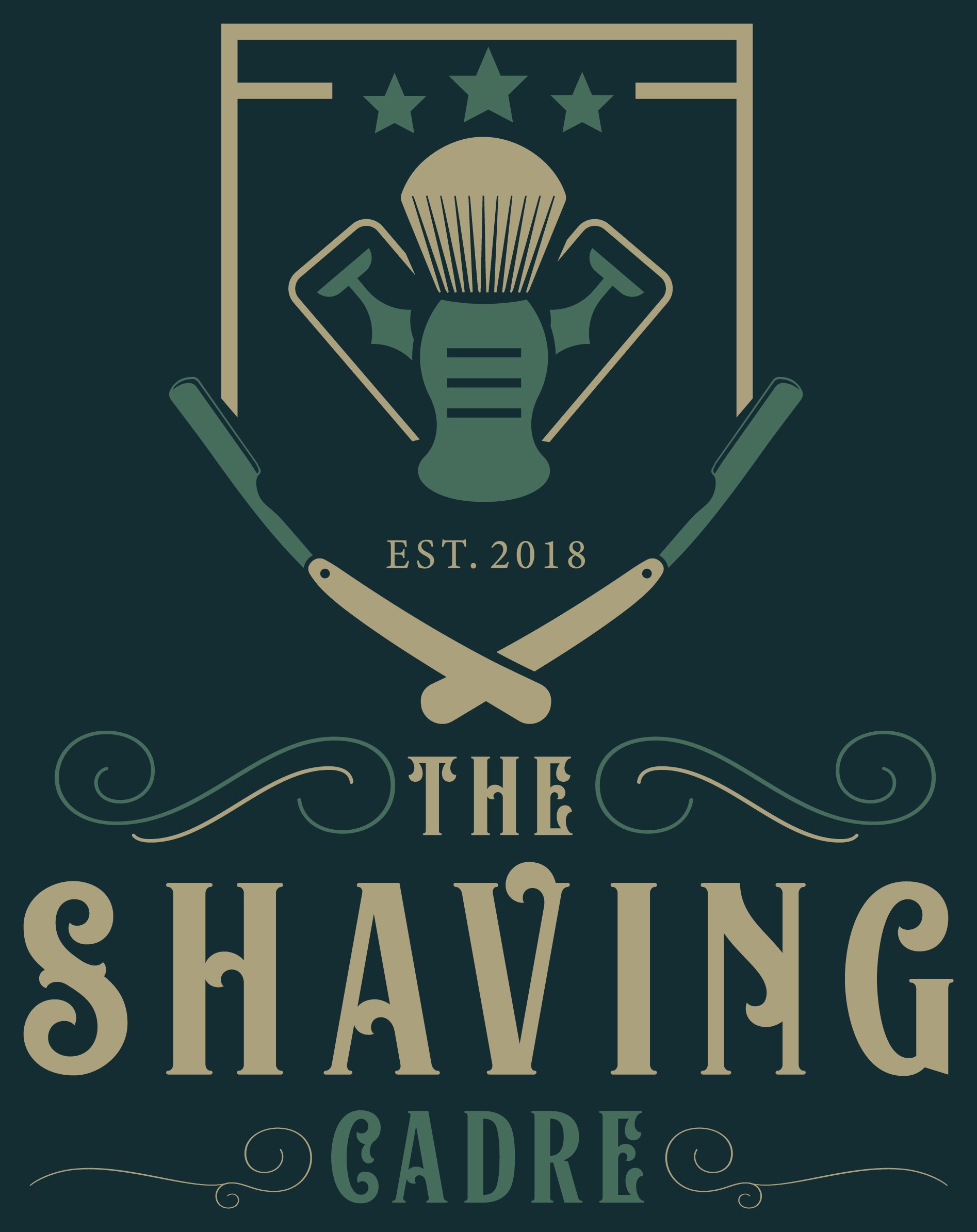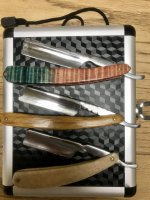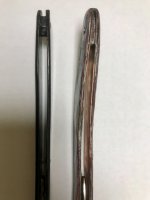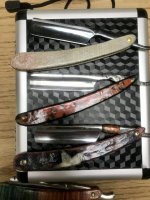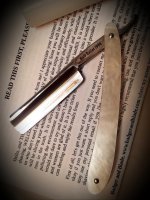I’ve done several GD66 mods. The blade is one part and making scales is the other. Unless what you get is really wonky out of the box, the only real modification you really need to consider is removing the shoulder/stabilizer so you can hone it to your liking. The resulting blade angle might be pushing the upper limits of what is considered a razors edge but the steel is good and holds the edge well. The popularity of the GD66 (@Slash McCoy buys enough from the factory to feed several families...)has really helped to Improve the consistency and make QC issues less of an issue. If you are very careful you can probably hone the blade to shave ready without any mods at all.
The easiest way to remove the shoulder is to use a barrel shaped sander the size of a ‘thumb notch” and grind a thumb notch into the tang. Whatever mods you do the biggest, number 1 rule is to NOT let the metal (especially at the cutting edge where it is quite thin) get hotter than you can stand to touch, or you will risk ruining the temper. So work the metal with your grinder a while, then cool the metal, then work it, etc. number 2 rule is to always have the grinder/sander turning in the same direction the blade edge is facing. NEVER face the edge into the spin of the grinder/sander. Number 3 is a strong suggestion because other than #1&2 I think the rest is up to you to figure out. #3 is to use a flat surface grinder/sander for all spine to edge work so to maintain the best possible geometry you are able. I use a dragster model sander (not available anymore in the exact configuration I have so I am stuck replacing parts) that has a dead flat center because I replaced it with parts to ensure it was flat. It also has a rounded nose for making thumb notches. I clamp it in a vice and go to town.
There are a lot of tricks. I’ve learned a few and I’m sure with the guys we have around hear there are more I can learn, so your imagination is probably the limit. Typical mods include thinning the tang, thumb notch, worked spine, altering the point (Spanish point, spike, barber-notch,etc), shortening, hollowing the blade more. You name it.
If you want to add more fun to the mix make your own mycarta scales. You can use paper, fabric or whatever strikes your fancy. I’ve made some cool material from light weight canvas. denim is cool too. Layered colored paper. The process is pretty simple, layers of your material coated with resin (use boat resin, it’s easy to get) wrapped in foil and pressed until set. I made a simple press with steel plates and bolts but clamps and wood would work too as long as you didn’t inadvertently stick everything together. Making scales isn’t particularly hard but it is something that you will need to watch some videos to learn. My scales aren’t pretty but they are interesting.
The easiest way to remove the shoulder is to use a barrel shaped sander the size of a ‘thumb notch” and grind a thumb notch into the tang. Whatever mods you do the biggest, number 1 rule is to NOT let the metal (especially at the cutting edge where it is quite thin) get hotter than you can stand to touch, or you will risk ruining the temper. So work the metal with your grinder a while, then cool the metal, then work it, etc. number 2 rule is to always have the grinder/sander turning in the same direction the blade edge is facing. NEVER face the edge into the spin of the grinder/sander. Number 3 is a strong suggestion because other than #1&2 I think the rest is up to you to figure out. #3 is to use a flat surface grinder/sander for all spine to edge work so to maintain the best possible geometry you are able. I use a dragster model sander (not available anymore in the exact configuration I have so I am stuck replacing parts) that has a dead flat center because I replaced it with parts to ensure it was flat. It also has a rounded nose for making thumb notches. I clamp it in a vice and go to town.
There are a lot of tricks. I’ve learned a few and I’m sure with the guys we have around hear there are more I can learn, so your imagination is probably the limit. Typical mods include thinning the tang, thumb notch, worked spine, altering the point (Spanish point, spike, barber-notch,etc), shortening, hollowing the blade more. You name it.
If you want to add more fun to the mix make your own mycarta scales. You can use paper, fabric or whatever strikes your fancy. I’ve made some cool material from light weight canvas. denim is cool too. Layered colored paper. The process is pretty simple, layers of your material coated with resin (use boat resin, it’s easy to get) wrapped in foil and pressed until set. I made a simple press with steel plates and bolts but clamps and wood would work too as long as you didn’t inadvertently stick everything together. Making scales isn’t particularly hard but it is something that you will need to watch some videos to learn. My scales aren’t pretty but they are interesting.
